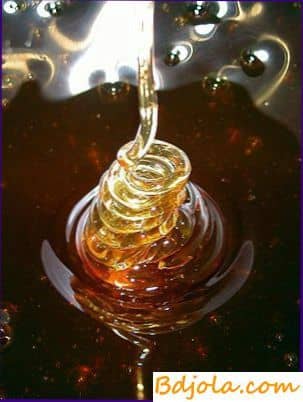Buckwheat honey

Buckwheat honey is dark yellow with a reddish tinge and dark brown color. Unlike other varieties has a peculiar flavor and specific taste. When crystallized, it turns into a gruel-like mass. Some tasters note that when eating buckwheat honey, it “tickles your throat.” Buckwheat honey contains 36.75% glucose and 40.29% levulose, as well as much more protein and iron than other honey varieties. In connection with this, such honey is recommended for treating anemia. This honey bees are made from nectar blooming buckwheat, which in Ukraine alone is planted annually by hundreds of thousands of hectares. From the nectar harvested from a hectare of blooming buckwheat, bees produce 60 kg of honey.
Buckwheat honey
Related posts:
- Reproduction of bee colonies Natural swarming of bees. In natural conditions, the increase in the number of families occurs by digestion. Swarming is a manifestation of the instinct of reproduction of a bee family. The swarming is as follows....
- Feeding base of beekeeping and measures to expand and improve it For successful development and high productivity of beekeeping, as well as any branch of animal husbandry, a powerful and stable fodder base is necessary. The feeding base of beekeeping is honey plants of field crop...
- Hibernation of bees Properly organized bee hibernation is one of the most important tasks in beekeeping. A good winter is considered to be a wintering, in which not only there is no escape of bee colonies or corn...
- Main properties of honey The color of honey depends to the greatest extent on what plants honey comes from. Thus, honey from white acacia, linden, sweet clover, alfalfa and clover is light in color, from almost white to pale...
- Work on an apiary at the end of a bribe and making nests for a winter Before the end of the honey collection, it is necessary to immediately begin to organize the hives and prevent the theft of bees, which can occur when the bribe breaks. Measures against the attack of...
- Diseases of adult bees The most common diseases of adult bees are caused by parasites; most pathogens of these diseases have microscopic dimensions (for example, the causative agent of nosematosis), but there are also visible by a simple eye...
- Species and breeds of bees Biological science, creatively developed by scientists, teaches that the entire animal and plant world, all living nature consists of separate groups of animals and plants, called species. There are many similarities between close species, which...
- How do bees talk to each other? The previous chapters talked about training, which allows you to get some data about the feelings of bees. The prerequisite for such experiments is that the bees we want to train come to our experimental...
- Honey food product The value of honey as a food and medicinal product. Honey is known as a food product for a very long time. Excellent taste qualities of honey are perfectly combined with its high nutritional content...
- Keeping the bees in working order In the bee families exhibited in January in the hothouse, a lot of broods appear in a week. To grow it you need honey, perga and water. In search of food, bees come into active...
- Properties of honey Honey has extremely great advantages over other food products: having good taste qualities, it is also a valuable curative and preventive agent. Bee honey is a wonderful gift of nature, in the creation of which...
- Internal structure of the bee’s body Muscles. The bee can produce a variety of movements: crawl, fly, bend the abdomen and sting, clean the antennae, perform various kinds of work – collect nectar and pollen, build honeycombs, etc. In addition, the...
- Transportation of bees The work begins with the development of a calendar plan for the use of bees for pollination of crops. Then they get acquainted with the basic methods of using bees on pollination of plants, taking...
- Chemical composition of honey Bees are adapted to highly specialized food. From nectar and pollen, they receive all the substances they need to reproduce, grow, develop and perform numerous works. Honey is a product of bee processing of plant...
- Digestion of pollen by bees Bees feed on pollen unevenly throughout life. In the early days. after leaving the cell, the bee eats a lot, which causes the midgut to increase greatly: the intestine volume from 6.7 mm3 increases to...
- Transportation of bees for pollinating crops It has long been observed that the best yield of fruits or seeds of crops and the greatest honey harvest are when the apiary is on the area of flowering crops or in the immediate...
- Use of a bribe About the main bribe. The time when the largest number of honey-plants blooming, giving bees abundant prey to nectar, is called the main bribe. The duration and abundance of the bribe depends on many factors:...
- Wax Economic importance of wax The value of beeswax for the national economy is extremely large. Thanks to a number of valuable properties, beeswax is the most important raw material for the socialist industry, and is...
- Allocation of nectar flowers of honey plants Nectar is a sweet liquid with an admixture of organic and mineral substances emitted by flowers and other glandular cells of plants. Allocate nectar to about a thousand species of plants, which are united under...
- Feeding of a bee family Among animals, as well as among people, there are sophisticated gourmands. But people have ample opportunities to satisfy their whims, whereas in animals nature has more strictly defined to each species what it can eat...
